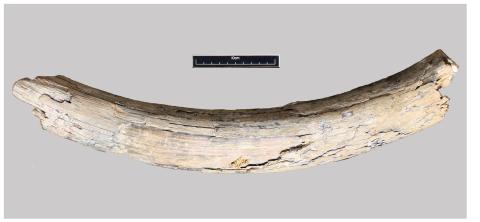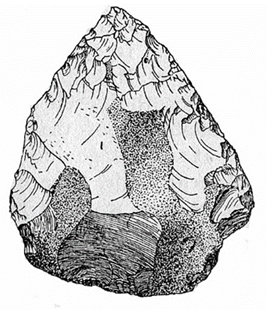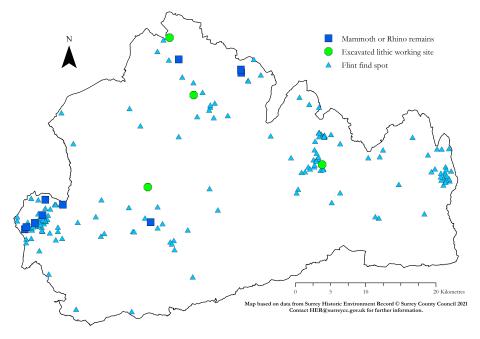The Palaeolithic period c. 850,000 - 9000 BC
The vast timespan of the ‘Stone Age’ – over half a million years – is often difficult to conceptualise, not least because it is represented by a wide diversity of artefacts and complexity of themes. The Palaeolithic (or ‘Old Stone Age’) is the era which begins with the earliest humans and ends with the retreat of the glaciers in the last Ice Age. Although much of our evidence is in the form of the flint tools left behind in the archaeological record, other sites from around Britain can give some insight into other aspects of material culture, including art.
 Church Lammas, Staines, c9000 BC (Late Upper Palaeolithic)
Church Lammas, Staines, c9000 BC (Late Upper Palaeolithic)
The site was identified from the recovery of characteristic flintwork in a gravel quarry and the evidence indicates that is likely to have been a temporary camp associated with the hunting of reindeer. The viewpoint looks approximately north across the tundra-like landscape of the floodplain associated with the Thames and Colne rivers. (Drawing by Giles Pattison, copyright Surrey County Archaeological Unit)
 As more and more scientific techniques are developed over the years, new advances are able to be applied towards research, allowing for more detailed results. One of the most significant methods which has developed in the last century is radiocarbon (or carbon-14) dating, which can provide age estimates for carbon-based materials derived from living organisms, based on residual radioactivity. Though this is given as a date range, rather than a specific age, the method can be very useful when applied to Palaeolithic material, whether charcoal from hearths or even mammoth tusks. One such tusk from Farnham (left) – uncovered in a gravel pit in the 1980s – was dated to 36,600 years ago, +/- about 2000 years.
As more and more scientific techniques are developed over the years, new advances are able to be applied towards research, allowing for more detailed results. One of the most significant methods which has developed in the last century is radiocarbon (or carbon-14) dating, which can provide age estimates for carbon-based materials derived from living organisms, based on residual radioactivity. Though this is given as a date range, rather than a specific age, the method can be very useful when applied to Palaeolithic material, whether charcoal from hearths or even mammoth tusks. One such tusk from Farnham (left) – uncovered in a gravel pit in the 1980s – was dated to 36,600 years ago, +/- about 2000 years.
 Non-carbon material can also be analysed through advanced techniques, including lithics. A study to characterise local flint sources was undertaken in 2010, assessing Palaeolithic flints from two Surrey sites – Wey Manor Farm and Church Lammas – through Laser Ablation-Inductively Coupled Plasma-Mass Spectrometric (LA-ICP-MS) trace element analysis, which showed correlations with a Salisbury Plain and East Anglian source respectively. Other times, the focus is on older collections, which are reassessed as information and records can be lost over the years, such as the on-going study of axes and flakes (right) collected around Farnham by Henry Bury.
Non-carbon material can also be analysed through advanced techniques, including lithics. A study to characterise local flint sources was undertaken in 2010, assessing Palaeolithic flints from two Surrey sites – Wey Manor Farm and Church Lammas – through Laser Ablation-Inductively Coupled Plasma-Mass Spectrometric (LA-ICP-MS) trace element analysis, which showed correlations with a Salisbury Plain and East Anglian source respectively. Other times, the focus is on older collections, which are reassessed as information and records can be lost over the years, such as the on-going study of axes and flakes (right) collected around Farnham by Henry Bury.
There are many resources on the Palaeolithic period in Surrey, including the period-specific pages on Exploring Surrey's Past and relevant sections in the Surrey Archaeological Research Framework. The Historic Environment Record (her@surreycc.gov.uk) is also the leading source of heritage information in the county, and has put together the monuments map for the Palaeolithic period below (based on current HER data). In addition, chapters in the South East Research Framework provide useful overviews of the region, including Surrey, as well as a wealth of additional sources.
 A downloadable A3 size leaflet on Palaeolithic Surrey has been put together by the Society in the hopes of providing a helpful overview and timeline of the period, illustrated with select images from excavations, research and fieldwork.
A downloadable A3 size leaflet on Palaeolithic Surrey has been put together by the Society in the hopes of providing a helpful overview and timeline of the period, illustrated with select images from excavations, research and fieldwork.
This is available as a printable double-sided pdf ![]() SyAS Palaeolithic flyer print version.pdf
SyAS Palaeolithic flyer print version.pdf
It has also been broken down into a more user-friendly version for reading, including the outer pages, inside map and HER map ![]() SyAS Palaeolithic flyer read-only version.pdf
SyAS Palaeolithic flyer read-only version.pdf![]() SyAS Palaeolithic map inside.pdf
SyAS Palaeolithic map inside.pdf ![]() Palaeolithic Surrey HER Map 2021.pdf
Palaeolithic Surrey HER Map 2021.pdf
For some further learning sources on Palaeolithic Surrey:
Bird, J and D G Bird (1987) The Archaeology of Surrey to 1540
Cotton, J et al (2004) Aspects of Archaeology and History in Surrey
Hunt, R (2002) Hidden Depths: an Archaeological Exploration of Surrey’s Past
Jones, P (2013) Upper Palaeolithic sites in the lower courses of the rivers Colne and Wey. Excavations at Church Lammas and Wey Manor Farm, SpoilHeap Publications Monogr, 5


